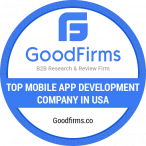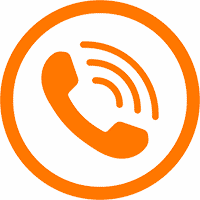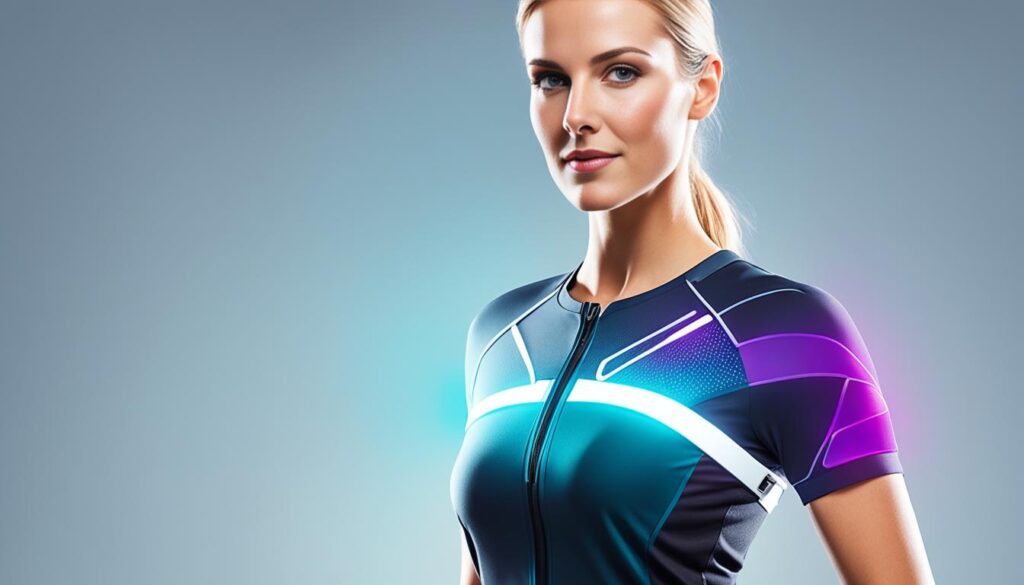Wearable technology is changing how we interact with the world. It’s a big deal in today’s fast-paced digital world. As more people want easy and smart wearable experiences, we need experts in wearable app development and integration.
This article looks into the world of wearable tech. It talks about its rise, the challenges and chances it brings, and what skills are needed for great wearable apps.
Table of Contents
Key Takeaways
- Wearable technology has changed how we use digital devices, opening up new chances for app development.
- Creating successful wearable apps means knowing how users behave, design rules, and how to integrate technology well.
- Working well with other systems is key for a smooth experience across different platforms and devices.
- Wearable apps are changing fields like healthcare and business, making things more efficient and engaging for users.
- New trends in wearable app development, like working across platforms and using advanced sensors, are shaping its future.
Introduction to Wearable App Development
Technology is always changing, and wearable devices have changed how we use digital info. Now, we see smartwatches, fitness trackers, and AR glasses everywhere. These devices make our lives easier and more personal. Learning about wearable app development is exciting, showing us new challenges and chances for developers and companies.
The Rise of Wearable Technology
Wearable tech has become super popular, with over 527 million devices shipped by 2023. People love how these devices track their fitness, health, and give info instantly. This has led to a new world for app making, where apps need to fit the special needs of these devices.
Challenges and Opportunities in Wearable App Development
Starting with wearable app development comes challenges. Developers face issues like making sure devices work together, designing easy-to-use interfaces, and keeping data safe. But these problems also mean new chances for creativity and making things more personal. By knowing what users like, developers can make apps that really help people, making their lives better. This growth of wearable tech also means companies can reach out to customers in new ways. They need experts in wearable app making to use these challenges to their advantage.
“The future of computing is wearable, and the future of wearables is apps.” – Tim Cook, CEO of Apple
Wearable App Development, Wearable App Integration, Wearable App Developers
Creating wearable apps needs a deep understanding of their unique challenges and chances. Developers must know how to make the most of the small screen size and work well with other systems. They need special skills to make great experiences.
The work of wearable app development is more than just making the app. It’s also about making sure it works well with other devices and systems. It’s important to have smooth data exchange for a good user experience.
Good wearable app developers know how to handle complex tasks like sensor integration and UX design. They understand what users want and need from wearable devices. This helps them make apps that are easy to use and fun.
| Key Skills for Wearable App Developers | Importance |
|---|---|
| User Experience (UX) Design | Designing intuitive and responsive interfaces for small screens and diverse input methods |
| Sensor Integration | Leveraging wearable device sensors to deliver meaningful data and insights |
| Platform-specific Development | Expertise in developing for specific wearable operating systems and frameworks |
| Data Synchronization | Ensuring seamless integration and data exchange with mobile devices, cloud platforms, and enterprise systems |
Working with skilled wearable app developers lets businesses make the most of this new technology. They can create solutions that make things better, improve health, and make users happy.
Designing Intuitive User Experiences
Making intuitive user experiences is key in wearable app development. These devices are different from regular phones because of their unique design and how people interact with them. It’s important to know what users like and how they behave. Designers should aim to make things easy to use, use touch and feel to help users, and work well with the device’s controls.
Think about how people use these apps, whether they’re moving or not using their hands. Making apps that fit into people’s lives easily is important. By understanding what users want and need, developers can make apps that are useful and don’t get in the way.
Understanding User Behavior and Preferences
Doing deep user research and analysis is the first step in making great wearable apps. By looking at how users act, what they struggle with, and what they like, developers can make better apps. Using feedback, testing, and data helps make sure the app meets users’ changing needs.
| Key Considerations for Designing Intuitive Wearable App Experiences |
|---|
|
“The ultimate goal of wearable app design is to create experiences that feel natural, intuitive, and effortless for the user. By deeply understanding their needs and behaviors, we can craft solutions that seamlessly integrate into their daily lives.”
Seamless Integration with Existing Systems
The world of wearable tech is always changing. Being able to seamlessly integrate wearable apps with what we already use is key. These devices connect to our phones, laptops, and work software. Making them work together smoothly is vital for a great user experience.
One big challenge in making wearable apps is making sure they work well with other systems. They need to share data and work together, giving users a single view of their info. This makes things better for the user and helps with data analysis and work flow.
| Integration Benefit | Description |
|---|---|
| Enhanced Data Analytics | By linking wearable apps with other systems, companies get deeper insights into how users behave, their health, and productivity. This leads to better decisions. |
| Improved Workflow Efficiency | With seamless integration, users can easily get to and manage their info on wearable devices. This makes tasks easier and boosts productivity. |
| Leveraging Existing Infrastructure | Linking wearable apps with what we already have, like phones and cloud services, helps businesses use their tech better and reach more users. |
Being able to seamlessly integrate wearable apps with existing systems is key to wearable tech’s success. By solving problems like data sharing and device linking, companies can offer a unified and useful experience. This encourages more people to use wearable apps.
“Seamless integration is the key to unlocking the full potential of wearable technology in the modern digital landscape.”
Wearable App Development for Healthcare
The healthcare world has seen a big change thanks to wearable app development. These apps and devices are now key for keeping track of patients’ health from afar. They help doctors and nurses monitor things like heart rate, medicine use, and other important health signs in real-time.
Remote Patient Monitoring
Wearable apps for remote patient care let doctors stay in touch with patients from anywhere. They work with devices to track things like heart rate, blood pressure, and activity levels. This helps doctors spot health problems early and take action, which can make patients better off.
Fitness and Wellness Tracking
Wearable apps have also changed the game for fitness and wellness. People can now track their activity, sleep, and overall health with these apps. This lets users take charge of their health and gives doctors the info they need to make better wellness plans.
It’s important to make sure wearable data is safe and private. App makers must protect sensitive health info well.
As healthcare keeps using wearable apps, we can expect better care for patients and better health for everyone. Wearable tech lets doctors give care that’s more personal, proactive, and efficient. This means patients can live healthier lives.
Enterprise Wearable App Solutions
In today’s fast-paced business world, leaders are turning to enterprise wearable app solutions to boost productivity and efficiency. These solutions combine wearable tech with apps to bring big benefits. They change how companies work.
By using enterprise wearable app solutions, companies give their workers tools for hands-free tasks, real-time data, and smooth communication. These tools make workflows better, improve teamwork, and help make quicker decisions. This leads to enhancing productivity and efficiency in the company.
Enhancing Productivity and Efficiency
Wearable apps for businesses offer many ways to make employees more productive and efficient. Some key features are:
- Hands-free task assistance, letting workers finish tasks without manual input or device use
- Real-time data access, so employees can get important info and make quick decisions anywhere
- Improved communication and teamwork, making it easy to share info and work together smoothly
By blending these enterprise wearable app solutions with tools like project management software, companies can make their operations smoother and more innovative.
| Feature | Benefit |
|---|---|
| Hands-free task assistance | Increases efficiency and cuts down on mistakes in completing tasks |
| Real-time data access | Helps in making quicker decisions and staying on top of business changes |
| Improved communication and teamwork | Boosts teamwork, sharing of knowledge, and overall quickness in the organization |
The need for enterprise wearable app solutions is rising. Forward-thinking companies are adopting these technologies to reach new heights of productivity and efficiency.
Wearable App Security and Privacy
Wearable devices are becoming more popular, making wearable app security and privacy very important. These apps handle a lot of personal data, like health info and where you are. This makes them a big target for hackers.
To keep user data safe, app makers need to use strong security steps. This includes:
- Encrypting data when it’s stored and sent
- Using secure ways to check who can access data
- Following rules like the General Data Protection Regulation (GDPR)
It’s also key to be open about how data is used and to let users control their privacy. Users should be able to easily see and change their privacy settings.
“Protecting user privacy is not just a legal requirement, but a fundamental responsibility for wearable app developers. Failure to do so can result in a loss of trust and significant reputational damage.”
As laws change, app developers need to keep up with new security and privacy steps. By focusing on wearable app security and privacy, they can make a safe space for users to use wearable tech.
Cross-Platform Compatibility
In the world of wearable tech, cross-platform compatibility is key to success. Making apps that work well with many devices is tough. But, creative teams are rising to the challenge.
Navigating the Wearable Device Landscape
The market for wearable devices is full of different kinds of hardware and software. From sleek smartwatches to tough fitness trackers, each one has its own needs. To make successful wearable apps, you need to understand this complex world. This means apps should work well on many devices with cross-platform compatibility.
| Wearable Device | Operating System | Key Features |
|---|---|---|
| Apple Watch | watchOS | Fitness tracking, heart rate monitoring, smart home integration |
| Fitbit Versa 3 | Fitbit OS | Comprehensive fitness and health tracking, GPS, music playback |
| Samsung Galaxy Watch 4 | Wear OS | Advanced health sensors, customizable watch faces, mobile payments |
Getting through this complex world needs a smart plan. It’s about using tools that work across platforms and making the most of each device’s features. With a flexible approach, developers can make sure their apps work well on many devices.
“The key to success in wearable app development lies in understanding the unique needs and constraints of each platform, and then crafting solutions that seamlessly bridge the gap between them.”
As wearable tech keeps changing, being able to work on many devices with cross-platform compatibility will set developers apart. By tackling this challenge, they can make the most of wearable tech and give users around the world amazing experiences.
Emerging Trends in Wearable App Development
The world of wearable technology is changing fast. New apps for wearables are moving into an exciting phase. Thanks to better sensors, machine learning, and artificial intelligence, we’re seeing big changes in how we use these devices.
One big trend is linking wearable apps with smart homes and cities. This connection makes life easier and more automated. With 5G, we can transfer data fast and interact without delay.
Voice commands and natural language processing are becoming key in wearable apps. People want easy, hands-free ways to use their devices. This is changing how we control and use our wearables.
| Emerging Trend | Impact on Wearable App Development |
|---|---|
| IoT Integration | Enhanced convenience, automation, and data-driven insights |
| Voice-based Interactions | Intuitive, hands-free user experiences powered by conversational AI |
| Sensor Advancements | Improved health monitoring, activity tracking, and personalized insights |
| Machine Learning and AI | Intelligent data analysis, predictive capabilities, and adaptive experiences |
Advances in sensors and machine learning are bringing new features to wearable apps. These include better health tracking and personalized advice. These changes are set to change how we use wearable tech every day.
“The future of wearable app development lies in the seamless integration of these devices with the broader technological landscape, empowering users with intelligent, adaptive, and intuitive experiences.”
The emerging trends in wearable app development are leading to a new era of innovation. Wearable apps will become more user-focused and advanced. By following these trends, developers can make apps that meet the needs of today’s tech users.
Choosing the Right Wearable App Development Partner
Finding the right partner for your wearable app is very important. It’s key to check their expertise and experience to make sure your project does well. Look for a partner who knows the technical side and gets the unique challenges of wearable tech.
Evaluating Expertise and Experience
First, look at the partner’s history in making high-quality wearable apps. Ask for examples of their work and what clients say about them. Make sure they know the latest in wearable tech, sensors, and how users interact with apps.
- Check their portfolio for experience with different wearable devices, like smartwatches and fitness trackers.
- See if they know how to connect wearable apps with mobile devices, cloud services, and other systems.
- Find a partner who keeps up with the latest trends and can offer advice to make your app better.
It’s not just about technical skills. Also, think about their ability to handle the tricky parts of wearable app development, like design and ongoing support. A good partner will help you from start to finish, making sure your app is a success.
“Choosing the right wearable app development partner can make all the difference in creating a product that truly resonates with your target audience.”
By looking closely at their skills and experience, you can find a wearable app development partner who will bring your idea to life. This ensures your wearable app does well in the long run.
Case Studies and Success Stories
Wearable app development is changing the game across industries. Our case studies highlight the amazing results our clients have seen. They show how wearable app integration is making a big impact.
In healthcare, we made a wearable app for a top hospital system. It let patients check their health from home. This cut hospital visits by 20% and made people healthier.
For a big fitness brand, we built a fitness tracking app that worked with their wearables. It made users more engaged, with a 35% jump in activity. People could track their fitness, set goals, and even compete with friends.
| Industry | Challenge | Solution | Result |
|---|---|---|---|
| Healthcare | Improving remote patient monitoring | Developed a wearable app with vital sign sensors and intuitive interfaces | 20% reduction in hospital readmissions, improved health outcomes |
| Fitness | Enhancing user engagement with fitness tracking | Created a comprehensive fitness tracking app synced with wearable devices | 35% increase in user engagement, improved customer experience |
These stories show how wearable app development can change things. Working with our experts, companies can get more efficient, innovative, and make customers happier.
“Wearable app development has been a game-changer for our business. The seamless integration with our existing systems and the intuitive user experience have driven remarkable results.”
Best Practices for Wearable App Development
Creating successful wearable apps means focusing on user experience, keeping data safe, and working well with other systems. Experts say these are key for wearable app success:
- User-Centric Design: Make apps easy to use, using wearable features to boost user interaction and productivity.
- Data Security and Privacy: Use strong encryption, keep data safe, and be open about how you use user data to gain trust and follow the rules.
- Platform-Specific Optimization: Make sure your app works well with the hardware and software of each platform for the best performance.
- Seamless Integration: Make sure your app works well with other devices, apps, and data sources for a smooth experience.
- Continuous Testing and Iteration: Test your app often, listen to user feedback, and keep improving it to meet changing needs and trends.
Creating successful wearable apps needs teamwork between developers, designers, and business experts. Working together on these best practices helps make apps that engage users and bring real value to businesses.
| Best Practice | Key Considerations |
|---|---|
| User-Centric Design | Intuitive UI, leverage wearable capabilities, enhance user engagement |
| Data Security and Privacy | Robust encryption, secure data storage, transparent user data policies |
| Platform-Specific Optimization | Tailored to hardware and software capabilities of each platform |
| Seamless Integration | Integrate with users’ existing devices, apps, and data sources |
| Continuous Testing and Iteration | Regularly test, gather user feedback, and continuously refine the app |
“Successful wearable app development requires a collaborative approach between developers, designers, and business stakeholders.”
Conclusion
The world of wearable app development is changing fast. It offers many chances for businesses and people to make things better, work smarter, and innovate. Wearable tech has huge potential in health, fitness, business, and more.
Getting the most out of wearable apps means working with experts. They can help with design, development, and making things work together smoothly. With their help, your wearable solutions will be easy to use, secure, and respect user privacy.
As wearable tech grows, keeping up with new trends and standards is key. By using wearable tech and the right partners, you can lead in the digital change. This will help your business succeed in the future.














